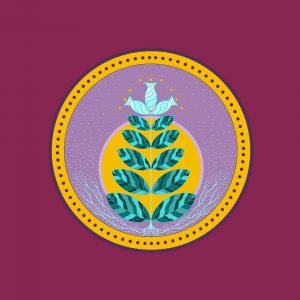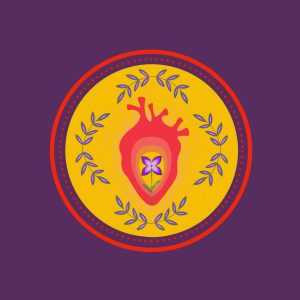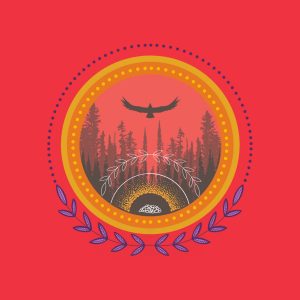National Day for Truth and Reconciliation, on September 30, honours Survivors of residential schools, the children who never returned home, and their families and communities. This year we have partnered with Atikamekw artist Eruoma Awashish, who draws on the theme of healing in her work, to evoke three key moments in the long journey of reconciliation: to prepare, mark and honour. Collective commemoration of our tragic and painful history, and the effects of residential schools, is a vital component of the reconciliation process.
Natokohiwemakan nehirowisi ocitakan e ocitakaniwok: Mamo ocitatan kitci mirerimoiikw Healing with Atikamekw art: creating together for wellbeing
As the National Day for Truth and Reconciliation approaches, we prepare for the day by acting in support of reconciliation. On September 30, we mark National Day for Truth and Reconciliation. We remind ourselves of the courage shown by Survivors, before, during and after the Truth and Reconciliation Commission. On October 4, we honour the Sisters in Spirit and the work of the Missing and Murdered Indigenous Women and Girls Commission.
Eruoma Awashish has created three illustrations centering on medicinal plants and on the theme of healing for these three key moments of truth and reconciliation.
Prepare. Healing.Tcictemaw.
We prepare for the day by acting in support of reconciliation

The tobacco plant evokes desires to advance in the reconciliation process. As we prepare for September 30, the second National Day for Truth and Reconciliation, this sacred medicine evokes the collective desire of Indigenous and non-Indigenous peoples to heal.
The image is also reminiscent of stars pointing us to greater interconnectedness with one another and with those who have come before us.
Tcictemaw (Tobacco) is a sacred medicine that we use in ceremonies to pray, to express our wishes and our desires. It needs to be sowed and be patient. The symbolism used throughout the project is anchored in healing by depicting medicinal plants: these need to be cared for and this takes time, attentivity and care. We cannot dictate the rhythm of nature to make the plants grow faster than their own rhythm. These medicinal plants will, in turn, care for us. In the same way, the reconciliation rhythm cannot go faster or slower that its own intrinsic rhythm. Everyone has their own pace. Reconciliation has its own pace.
– Eruoma Awashish
Mark. Courage. Mackowerimowin
We mark the National Day for Truth and Reconciliation and honour the courage of Survivors.
 The flower at the centre of the image is often used in Atikamekw culture, and is known as Quatre-temps (Four-times, or Four-beats). The heart, at the centre, evokes a heartbeat, just like the rhythm of the drum, that brings unity. The heart is a symbol for courage, a reminder on National Day for Truth and Reconciliation of the courage it took for Survivors of residential schools to bring forth truth.
The flower at the centre of the image is often used in Atikamekw culture, and is known as Quatre-temps (Four-times, or Four-beats). The heart, at the centre, evokes a heartbeat, just like the rhythm of the drum, that brings unity. The heart is a symbol for courage, a reminder on National Day for Truth and Reconciliation of the courage it took for Survivors of residential schools to bring forth truth.
This flower is usually white, but it was tinted in purple to commemorate Joyce Echaquan, also Atikamekw.
In the Atikamekw language, the word mackowerimowin (courage), like the word mackowisiwin (strength), is rooted in the word masko, which means “bear”.
– Eruoma Awashish
Honour. Land. Notcimik.
We honour the lives of Missing and Murdered Indigenous Women, Girls and gender-diverse people.
 On October 4, we continue our work for Truth and Reconciliation by commemorating the Sisters in Spirit Vigil, to honour the lives of Missing and Murdered Indigenous Women, Girls and gender-diverse people.
On October 4, we continue our work for Truth and Reconciliation by commemorating the Sisters in Spirit Vigil, to honour the lives of Missing and Murdered Indigenous Women, Girls and gender-diverse people.
The forest – Notcimik – illustrates the land that Indigenous and non-Indigenous peoples share. Red is an important colour for this day.
The eagle is a sacred symbol, high-above closer to the Creator in Atikamekw culture and many Indigenous cultures. That is why many Indigenous peoples will pray with a feather. The ark below evokes a sweat lodge, representing the mother’s womb, where we can be renewed, heal physically, emotionally and spiritually from our collective hurting and to better re-born.
The forest evokes home, a safe place and a place of connection with our deep inner nature and the land. Connecting with and recharging in the forest is beneficial for our collective healing.
– Eruoma Awashish
A note on the artist
Eruoma Awashish is from the Atikamekw Nehirowisiw Nation and grew up in the community of Opitciwan. She is now established in Pekuakami (Lac-St-Jean) and her studio is located in the Innu community of Mashteuiatsh. Her artistic approach is steeped in spirituality and aims to create spaces for dialogue to foster a better understanding of First Nations cultures. The decolonization of the sacred is at the heart of her practice.
Reconciliation requires concrete actions year-round. Bringing about the resources and actions for reconciliation to become a reality requires consistent and concrete actions. In the last year, we have increased our funding for reconciliation-focused projects and our impact investments. Staff and leadership have been preparing themselves for the occasion by connecting with one another, in ceremony, through volunteering with our partners, training with the Four Seasons of Reconciliation and journeying with all our Indigenous partners, as we continue to connect through actions to bring about reconciliation for ourselves and future generations.
We welcome and invite your responses to this project: communications@mcconnellfoundation.ca.
